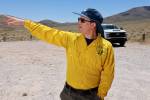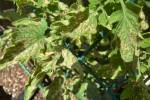Red Rock spraying operation targets non-native grass
Workers with herbicide sprayers will soon fan out across Red Rock Canyon, as the Bureau of Land Management goes to war against a non-native grass that increases the risk and severity of wildfires.
Starting in October, contract spray crews will target red brome grass and its seed stock along roads and trails and in areas within the Red Rock scenic loop that were scarred by large wildfires in 2005 and 2006.
The operation marks the first large-scale use of herbicides within the national conservation area. The goal is to create fire breaks up to 300 feet wide to help firefighters control future blazes and limit their size.
The arrival of fast-spreading, non-native grasses has caused problems across the West, leading to something experts call the "invasive annual grass fire cycle."
Sean McEldery, fire management specialist for the BLM at Red Rock Canyon, said the grass basically provides ground-level fuel for fires where there wasn't any before, allowing otherwise small, isolated fires to spread quickly. The result can be what is known as a "landscape-level fire" that clears away native cover, allowing more invasive grass to take root.
"The Mojave (Desert) isn't super flammable on its own," McEldery said.
The fuel-reduction plan at Red Rock calls for two different herbicides to be used on 4,460 acres, more than half of it in areas burned by two lightning-sparked fires - the 821-acre Loop fire in 2005 and the 1,500 acre Scenic fire in 2006.
McEldery said those fires were made worse by red brome, which has since taken off in the burned areas.
Because it's a cool-weather grass, red brome tends to sprout earlier in the year and squeeze out native plants, he said.
The spraying operation has been in the works for four years. An environmental assessment of the idea would allow for the herbicide to be applied from the air using a helicopter, but Red Rock officials opted for hand-spraying instead to limit the number of native plants and animals accidentally exposed to the chemicals, McEldery said.
The operation was scheduled for the fall and winter to avoid the active period for the desert tortoise, migratory bird season and foaling time for wild horses and burros.
"We can't do this anytime of the year," McEldery said. "The real key for us is the timing."
The spray crews also will be instructed to avoid washes and any concentrations of sensitive plants and animals, he said.
They are slated to complete their work by the end of February. If inclement weather or other factors keep them from finishing on time, they will stop for the spring and summer and resume spraying in September 2013.
McEldery said some areas will be off limits to the public during and immediately after the herbicide is applied, but he does not expect any of the closures to last more than about 24 hours.
Contact reporter Henry Brean at hbrean@reviewjournal.com or 702-383-0350.























